Madagascar Jasmine: [Growing, Care, Pests and Diseases]
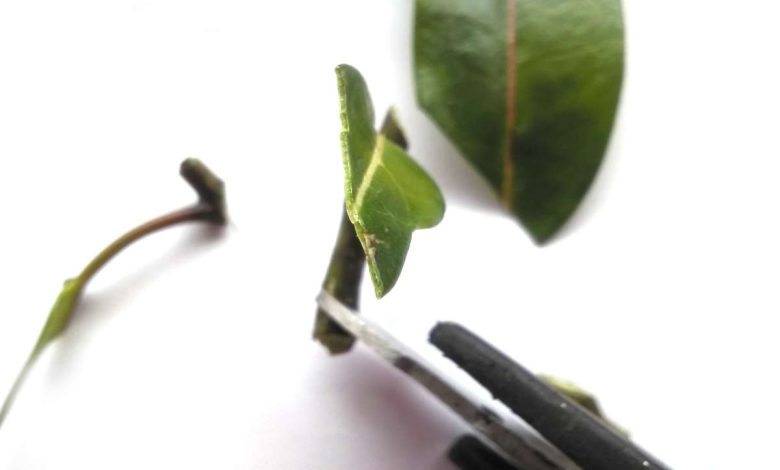
Important points when planting Madagascar jasmine
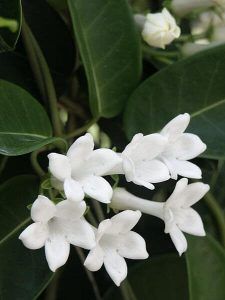 When? In spring it is a good time to sow and transplant to another pot.
When? In spring it is a good time to sow and transplant to another pot.- Where? It lives in gardens, near walls, pergolas, in pots that give it stability to grow like a vine.
- How do we prepare the land? A substrate of organic origin and perlite will be excellent for its full development.
- How do we sow? In a pot, near walls, pergolas and with the help of stakes so that they can climb. And in gardens.
- How do we pay? Every 20 days in spring and summer. Otherwise, once a month withorganic fertilizer.
- When do they bloom? In spring-summer white flowers bloom with a wonderful aroma. They can reach fall in ideal conditions.
- Ideal temperature? It likes warm temperatures, a little high, but it can’t stand frost and cold currents. The idea is 18ºC.
- How do we water? Once a week, moderate watering is sufficient, but they will be longer between October and January, when the plant rests.
What is Madagascar jasmine?
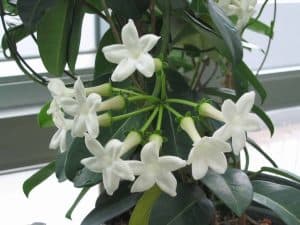 The Stephanotis floribunda, Jasmine or Madagascar Jasmine, is a perennial shrub, with green foliage throughout the year, which comes from
The Stephanotis floribunda, Jasmine or Madagascar Jasmine, is a perennial shrub, with green foliage throughout the year, which comes from
Actually, it is a very generous plant, with very green leaves. On each branch there are usually about 7 opposite leaflets, where, like common jasmine, one is longer at the tip.
The white flowers are solitary but numerous, they open one by one and give off a very delicate aroma that envelops the whole environment in the afternoon, although a little less strong than that of the Jasminum officinale.
Where should we plant it?
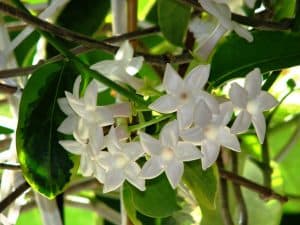 It can live peacefully in gardens and terraces, with good light and moderate hydration, in semi-shaded places and with natural light.
It can live peacefully in gardens and terraces, with good light and moderate hydration, in semi-shaded places and with natural light.
So the ultimate planting site should be somewhere in the middle between intense sun and full shade.
It can also cover walls by growing it as a climbing plant, in pergolas and to cover large surfaces.
A pot containing a metal cone in the center is ideal for making the plant grow around it, coiling up.
When should Madagascar jasmine be grown?
In spring, it is the auspicious date to sow and transplant to a larger pot.
How do we prepare the land?
It loves very spongy and fertile soils, with good drainage. A universal substrate containing peat is of great benefit to this vine.
How to plant a Madagascar jasmine step by step?
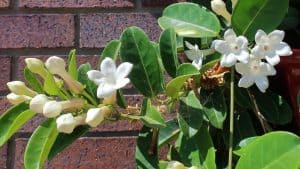 They can be reproduced fundamentally in two ways, with a cutting planted directly in the fertilized soil, and placing it in water.
They can be reproduced fundamentally in two ways, with a cutting planted directly in the fertilized soil, and placing it in water.
When the plant is in bloom, another method can be adopted that also works very well. Let’s see.
by leaves
- Select healthy and strong leaves, the healthiest, to cut them with great care so as not to affect the central stem from which they hang. About 6 sheets will be more than enough.
- Take them to the work table, where 2 pots will be previously prepared: a pot with fertilized, moist soil and a wide-mouthed plastic container with river or rain water.
- Plant the stem of each leaf in the pot with soil and submerge the other three leaves in the water.
- Wait for the roots to come out. In both rooting processes, good success is always achieved by placing them in a lighted place, in semi-shade.
- Proceed to the transplant in the final pot when enough roots sprout in water.
by cuttings
- Cuttings from healthy branches, preferably secondary branches, are selected and freed from most of the leaves to strengthen the shoot.
- They are planted in a pot with a good universal substrate and peat, so that it has good drainage and about 3 cuttings are planted about 6 centimeters deep.
- The pot must be covered with a plastic protector, in a place where it is kept at an ambient temperature of about 20ºC.
- The roots will take a while to appear, but it will be normal.
- Water sparingly to prevent the roots from rotting from excess water.
- In about two months the plants will have all the vigor required to fully develop in the pot.
To know more, you can see: Jasmine cuttings.
What care does the Madagascar jasmine need?
Lightning
It really likes to stay between sun and shade, which help its growth to be fast. That is, it requires a lot of light, but not direct sun during midday.
If the daughters turn yellow, then it needs more light, perhaps placing it near a window or on a terrace will solve the problem.
Temperature
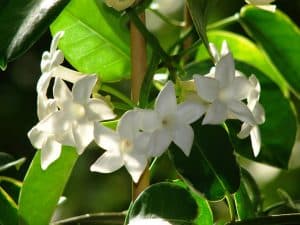 You have to protect it a lot from frost, because its leaves are very fleshy and it does not tolerate extreme cold. And if you get a very severe cold snap, you will surely be left without leaves.
You have to protect it a lot from frost, because its leaves are very fleshy and it does not tolerate extreme cold. And if you get a very severe cold snap, you will surely be left without leaves.
So it’s time to protect it from the cold winds of the North and the icy nights. The ideal is 18ºC, it should never drop below 10ºC or exceed 30ºC.
Indoors, the humidity to be taken care of needs to be in balance. Spraying frequently is recommended inside the house. It is greatly harmed indoors by heating.
Irrigation
The irrigation water must be moderate, allowing the substrate to always remain moist but never soaked.
You can receive water in sprays, but very humid environments are not recommended for your well-being. During the plant’s annual rest period, which is between autumn and winter, it should be placed in a cool place, away from heat sources, with spaced watering and no fertilizer.
If this period of rest is not respected, the flowers will not sprout in abundance during spring. A saucer under the pot with water beyond the required time, less than 10 minutes, will cause root rot. And if the buds dry out, then you need more weekly watering.
Pass
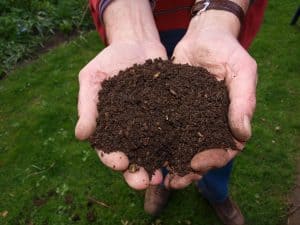 To receive a good fertilizer 15-15-15 or organic fertilizer, manure, earthworm humus, every 15 days, or once a month.
To receive a good fertilizer 15-15-15 or organic fertilizer, manure, earthworm humus, every 15 days, or once a month.
In summer and spring it is also appropriate to apply a natural liquid fertilizer every 20 days and the surface soil must also be renewed periodically.
Every spring, year after year, it is highly recommended to change the plant to a larger pot, but if it has grown a lot and has already climbed high, then it is enough to renew the surface substrate for a fresh one to oxygenate it.
If you notice that the leaves at the base are dry and ugly, then you have to renew the substrate with organic fertilizer and change the water for rainwater to eliminate a possible excess of lime.
Pruning
It is convenient to prune it, but only when necessary because in the garden it is better to leave it free.
It is important that it expands near a wall so that it can climb or prepare a frame nailed to a wall and help it hold the twigs, with support on strips that delicately hold its branches to guide it where we want to take it.
There are those who hold it in a pot with a bamboo cane, near a wall to guide it in its climbing growth. This vine plant can live for many years if we learn to take care of it.
What pests and diseases attack the Madagascar jasmine?
 A typical disease of jasmine is the occurrence of viruses, which cause a lot of mottling, various leaf spots, chlorosis and alarming necrotic lesions that invade the flowers.
A typical disease of jasmine is the occurrence of viruses, which cause a lot of mottling, various leaf spots, chlorosis and alarming necrotic lesions that invade the flowers.
Until the weakening of the plant is generalized and the terminal buds die. This doesn’t happen often, but it can happen.
Bothersome pests such as aphids, mealybugs and mites must be scared away and eliminated with soapy water and sprayed on the leaves with an effective insecticide with a low chemical formulation. The recommendation of a specialist will be invaluable in this case.
To know more, read: Jasmine varieties.

![Photo of How to Plant Macadamia Nut in [8 Steps + Images]](https://www.complete-gardening.com/wp-content/uploads/2022/08/how-to-plant-macadamia-nut-in-8-steps-images-390x220.jpg)
![Photo of Cucurbits Angular Spot: [Characteristics, Detection, Effects and Treatment]](https://www.complete-gardening.com/wp-content/uploads/2022/08/cucurbits-angular-spot-characteristics-detection-effects-and-treatment-390x220.jpg)
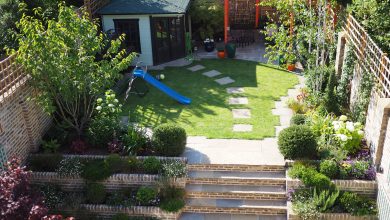
![Photo of Potted Olive Tree Care: [Soil, Humidity, Pruning and Problems]](https://www.complete-gardening.com/wp-content/uploads/2022/08/potted-olive-tree-care-soil-humidity-pruning-and-problems-390x220.jpg)